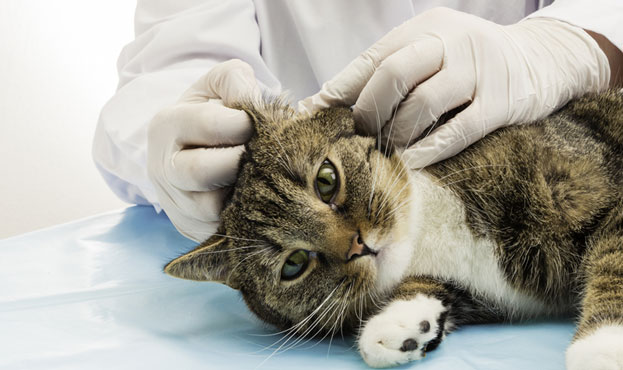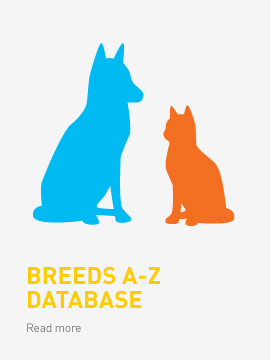Why is it important to vaccinate?
When puppies and kittens are born, their immune systems are not fully mature. They rely on protective antibodies in their mother’s milk. However, this maternal immunity wanes within the first few weeks of the baby’s life. There are a number of serious viral diseases that cause high death rates in young, vulnerable animals. These diseases in puppies include Canine Distemper and Canine Parvo. In young kittens, Feline Distemper (FVRCP) is a very serious viral disease. The Rabies virus can infect any mammal and is 99.9% fatal. Only 2 or 3 humans in history have survived active infection, thanks to advanced, modern medicine. These terrible diseases are preventable by vaccination.
What if I want my pet to acquire immunity “naturally”?
Young animals have a “natural” immunity from the mother only if she was naturally infected with the virus and survived the illness or was vaccinated herself. This is one of the reasons that veterinarians urge owners to vaccinate their puppies and kittens starting around 6-8 weeks of life, when maternal protection has worn off.
If you want your pet to acquire immunity “naturally” – this means that your pet must be sufficiently exposed to the live virus and mount a significant immune response. This typically happens when pets are infected with the virus and live through the illness. Infection with these viruses causes severe sickness and often death. “Natural” immunity is not worth it – vaccines are a much safer and more responsible option. Puppies and kittens need a series of 2-3 vaccines may be needed in order to achieve protection against these diseases. Generally, the Rabies vaccine is first given at 12 weeks of age.
Vaccines are “boostered” at one year of age for both dogs and cats. After this vaccination, your pet may be vaccinated every year or every 3 years, depending on the availability of these longer-lasting vaccines. Even though antibody tests (called ‘titers’) can be checked at a laboratory on your pet’s blood sample to determine immunity levels, this option is often 3-5 times more expensive than giving a vaccine every 1-3 years.
What is Canine Distemper?
Canine Distemper is caused by a virus and enters the body through the nose and oral cavity. Nasal and oral secretions harbor the virus from dog to dog. Crowded shelter conditions with unvaccinated animals are a common scenario in an outbreak. Even dogs that do not show symptoms can shed the virus for 2-3 months after recovery. Symptoms include eye and nose discharge, fever, coughing, pneumonia, calluses on the feet and nose, full-body tremors and seizures. Some dogs who seem to have beaten the disease may develop neurologic symptoms and seizures weeks later. Some neurologic signs are permanent and the pet often is incapacitated and succumbs to the disease.
What is Canine Parvovirus?
Canine Parvovirus or “Parvo” is a very hardy virus that is ubiquitous in the environment. The reason that veterinarians discourage new puppy owners from taking their pup to the dog park is that infective particles can live in the soil for years. Once the puppy has a full set of vaccines, it is safer to expose them. It is extremely difficult to disinfect for this virus. Unvaccinated puppies typically become infected with the disease. It is rare for an older dog to get parvo, but it is possible, especially if the immune system is weak or if they have never been vaccinated. Puppies are infected with parvovirus by contact with infected soil or feces.
The virus attacks in two important ways. First, it infects the bone marrow, where the puppy makes the cells that run the immune system. Without these helpers, the virus is able to invade other parts of the body and ‘disable’ or severely weaken the immune system. The virus attacks the lining of the intestine, causing severe and often bloody diarrhea and vomiting. The intestine is left with “holes” – which allows other pathogens access to the bloodstream. Most puppies die from the disease due to extreme body fluid loss and dehydration.
What is Feline Distemper (Panleukopenia)?
cerebellar hypoplasia
What is Rabies?
Rabies is caused by a virus and is spread through the saliva. Most commonly, mammals are infected through a bite wound. Within days to months after the bite, severe neurological disease ensues. The animal goes through several phases of symptoms, including depression, appetite decrease to mania and severe aggression. This terrifying disease progresses to death often within 10 days - after the virus causes paralysis and the victim suffocates.
The virus is carried by domestic animals and wildlife. It is often seen in feral or stray cats and dogs that have had contact with rabid wildlife, such as foxes, skunks, raccoons and bats. A lovely stray kitten with a small healing wound could be harboring this deadly virus.
Most countries around the globe have Rabies vaccination laws and controls in place to prevent human and animal disease. Kittens and puppies should be vaccinated around 12 weeks of age (depending on local law) and this vaccine is repeated at one year of age. After one year of age, a 1-year or 3-year vaccine can be administered.
Vaccine FAQs
Do vaccines hurt?
The initial injection will sting a little due to the needle being inserted under the skin. Some pets may experience some tenderness for a day or two after the vaccine, while others don’t seem to notice a thing!
Can my pet get cancer from a vaccine?
Certain cats may be at risk of developing a type of cancer called Feline Injection Site Sarcoma (FISS) after vaccination. This disease was formerly known as Vaccine-Associated Sarcoma. Recent research has also shown that there may be a genetic component to this, as some cats develop sarcomas after being injected with medications or saline and not vaccines. One of the possible vaccine components thought to trigger sarcomas, an aluminum-based adjuvant, has been removed from use in most vaccines today. The incidence of FISS in the United Kingdom in 2007 was approximately 1 case in 16,000-50,000 cats. It can be concluded that the incidence and therefore risk is very low.
Due to this small risk, veterinarians place vaccines and other types of injections in cats differently from those in dogs. If a sarcoma does develop from the injection site, the location is easier to operate, possibly saving the animal’s life.
If your cat or dog develops a lump in the area of the injection, it may simply be a normal inflammatory response, but let your veterinarian know about it as soon as possible. Most inflammation will dissipate within a few days. If you have an older cat that was vaccinated in the 1990s or early 2000s, be aware that FISS can show up years after the initial vaccines. You can examine your cat for skin lumps just by petting and massaging him or her daily…your cat will appreciate it!

Parasites
Internal and external parasites have plagued cats and dogs since time immortal. Puppies and kittens are often exposed to parasites by their mothers – even through breast milk! Here is a quick reference list of the most common parasites.
Roundworms
Roundworms cause intestinal upset (vomiting, diarrhea) and can occasionally cause blockage in large numbers. Roundworms have a remarkable lifecycle which is almost impossible to break. This is why roundworms persist as a problem for both animals and humans. Puppies and kittens are most commonly infected in the womb while they are still embryos! Even if the mother dog has been dewormed, there can still be inactive roundworm cysts living in her liver. The cysts are activated during pregnancy and infect the embryos. They can also be passed through the breast milk. When your puppy or kitten is seen by the veterinarian, a fecal sample will be examined for roundworm eggs. Deworming will be necessary to prevent intestinal disease. If your dog is pregnant, it is possible to prevent puppies from being infected in the womb – products called moxidectin and fenbendazole can be used under direction of your veterinarian.
Roundworms can cause infection in humans – most commonly children. Children can suffer from a form of blindness if infected by roundworms. Good hygiene and yearly fecal screening for your pets will help protect humans from infection.
Hookworms
Hookworms are common in puppies and kittens. Adult dogs can also be infected by ingesting feces or contaminated soil. Hookworms can also infect dogs (and humans!) by crawling through exposed skin from the environment in their tiny larval stage. Hookworms can also be transferred much like roundworms – through the breast milk of the mother or the pups are infected in the womb. Hookworms infect the intestines and suck host’s blood. Severe infections can lead to diarrhea, anemia and weakness.
Hookworms causes a disease in humans called cutaneous larval migrans, which means the worm burrows through the skin, leaving pain and inflammation in its wake. Hookworms can also infect a human’s digestive tract. If you go to a beach with dogs – be aware that you might bring more home with you than just sand between your toes! Dog owners need to be aware that their dog may be shedding hookworms and pick up the feces for proper disposal – this will help prevent the spread of hookworms in the environment.
Echinococcus tapeworm
It is important that people travelling with their pet be aware of this tapeworm. Several nations within Europe require a special deworming to prevent the entrance of this worm into their country. Why is it so important?
Echinococcus, also known as Hydatid Cyst, are found world-wide and infects dogs, cats, foxes, wolves, rodents, rabbits and coyotes. Sheep can act as an intermediate host to the parasite. Pets that live outdoors and hunt are susceptible to infection. If Echinococcus infects humans, it causes a hydatid cyst, which can occur in the liver, brain or muscles. These are ‘malignant’ cysts which have a high mortality rate (for example, of those with a lung cyst, 70% die within 5 years of diagnosis, even with treatment). It is important to not feed your pet offal from sheep that may be infected in endemic areas.
Ask your veterinarian if Echinococcus is a problem in your area and deworm your pet accordingly.



